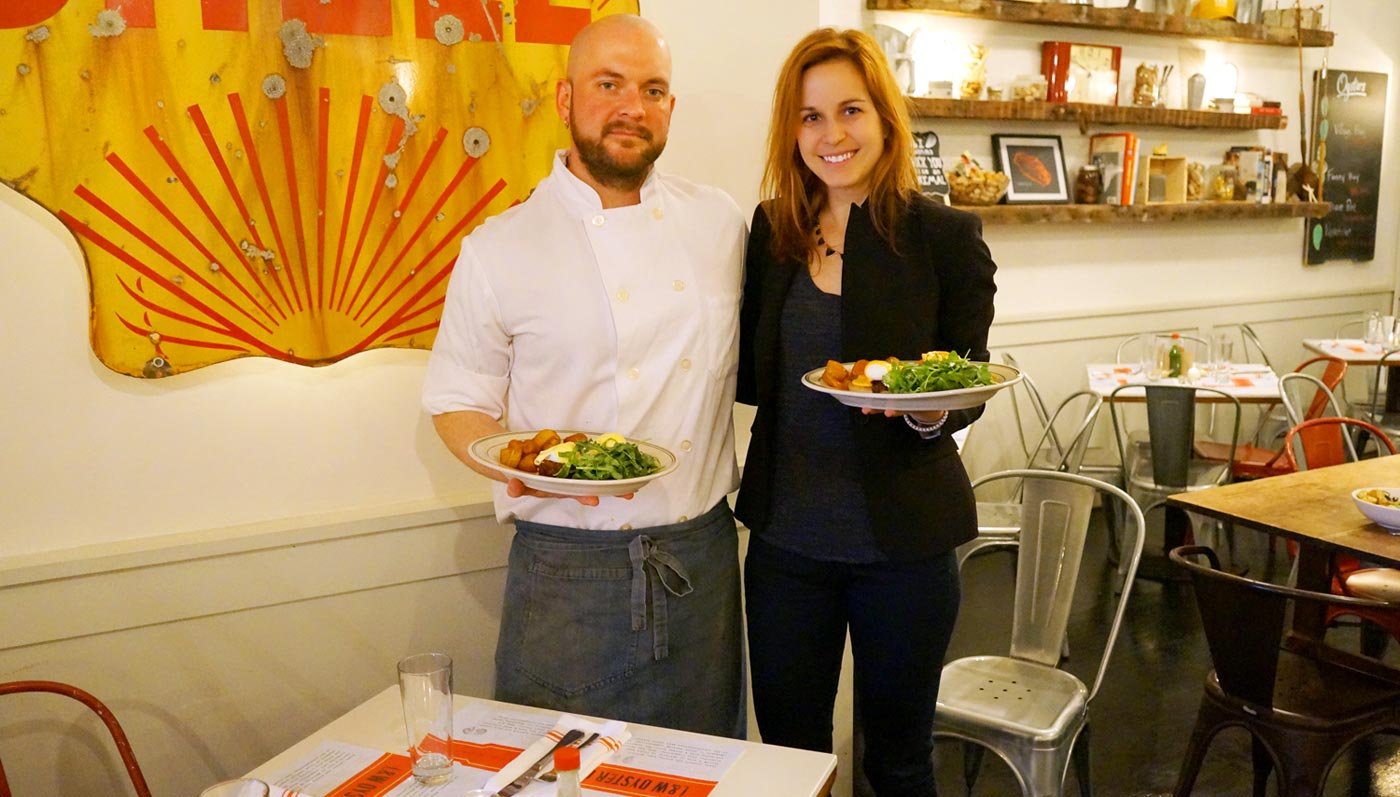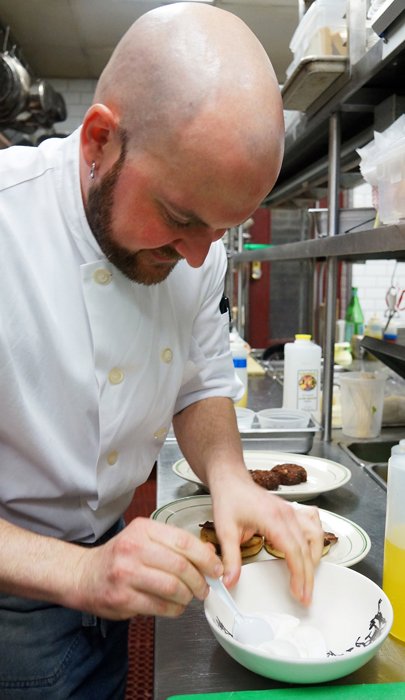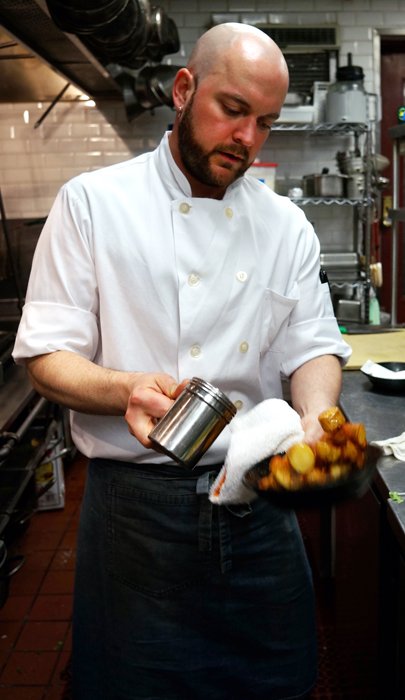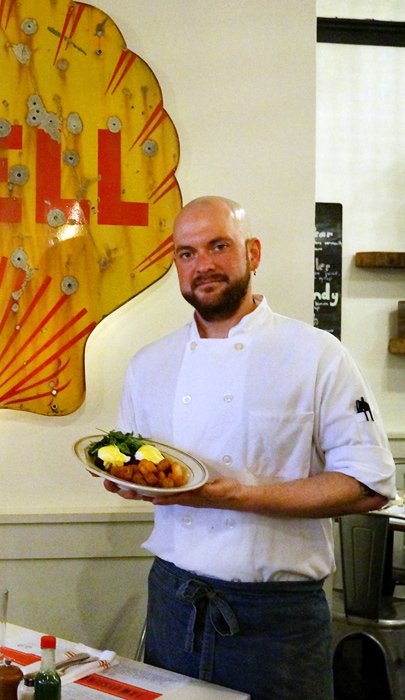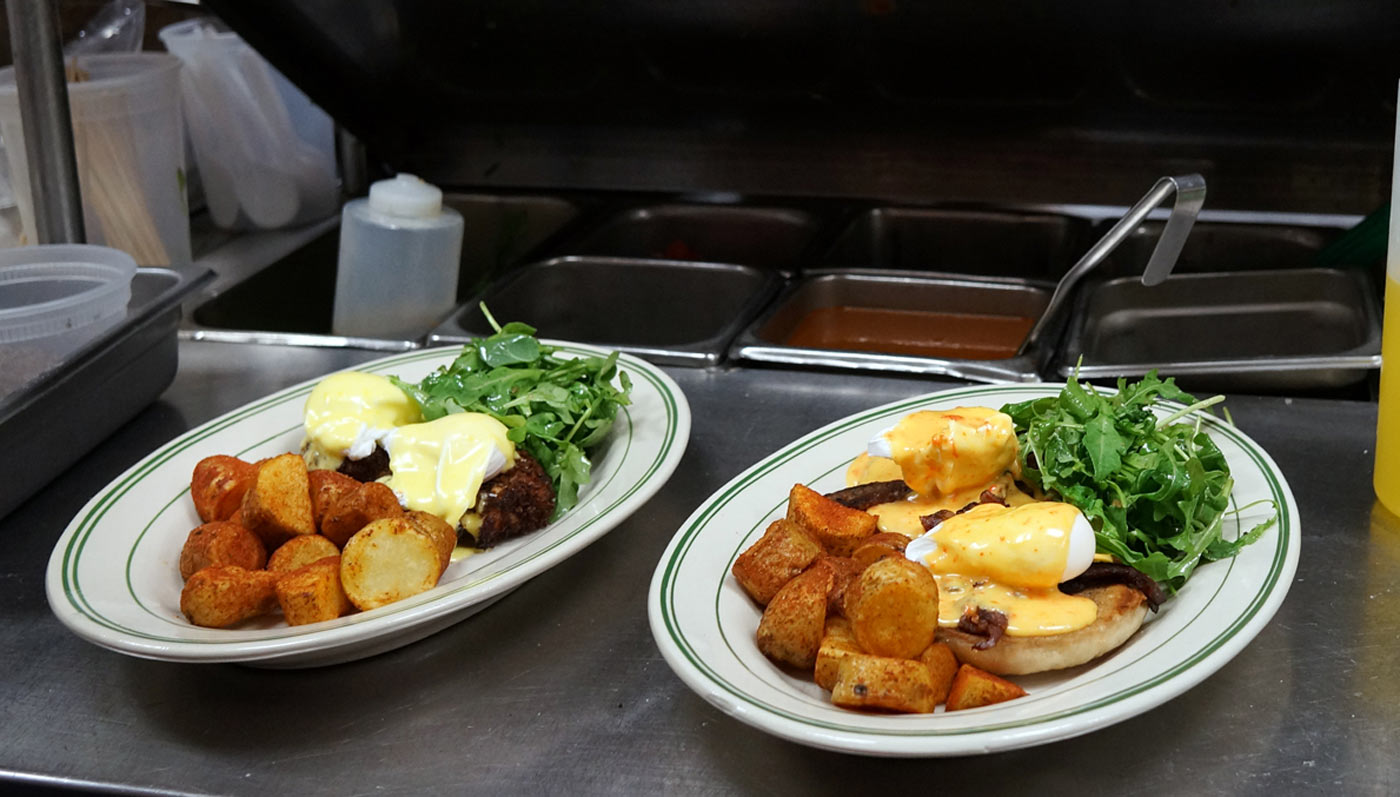CHEF DAVID BELKNAP’S ANGRY CRAB BENEDICT RECIPE
While sitting down with Chef de Cuisine David Belknap of L&W Oyster Co., I quickly realized that this wasn't just a story about how fun, kind and creative a chef he is (all of which are true). Rather, this a prideful conversation about the creation, transformation and physical journey of his signature crab cake—a journey, that mirrors that of his own.
Talking with Chef Belknap felt effortless, like pulling up a chair and sitting down with a friend you've grown up with. During our interview, we talked about everything from his culinary history that explores city to city, to the specifics of L&W's produce and purveyors, to their delicious bottomless brunch menu. After it all, he took me into his kitchen to make me two of his Benedict dishes on those famous crab cakes of his—talk about delicious! Hello, lobster-y Benedicts! I can't even. I know, so many thoughts! Well, I'll let him answer all of the questions (go on, read on)!
You must go try it for yourself at L&W Oyster Co.!
If you're daring, his recipe is at the end of our interview for you to make at home!
MW. After working in restaurants like Per Se and The Ritz Carlton (in Naples Beach, Denver and Grand Lakes) you have found a home here at L&W Oyster Co. It’s hard not to see that there is a very clear change in atmosphere, vibe, and clientele. Is this the aesthetic that you would say that you best relate to as a chef?
ChefDB. I do. The majority of my career has been spent in like casual dining restaurants, things like that—not chain restaurants but they've always been local like mom and pop little bar and grill type things. And, the past seven years I have stepped up to the luxury market and the Ritz Carlton and Per Se and I think that is kind of something that I needed personally as a chef to grow because I didn't really know the fine dining aspect of it, I didn't really know the high-end food. But I think the way I kind of built out my career really worked out well for me because I'm not necessarily stuck doing fine dining food but I have the basis of really good cooking. So, it's like whatever I make is going to taste amazing. But then, once I learned the fine dining aspect of it, then I can start crafting the visual of the food rather than just the flavors. So this place, L&W is kind of a melding of everything I've always worked for. everything I've always learned.
MW. Would you say it's like "comfort food" elevated?
DB. Yeah, that's the kind of thing I like to do. I like to try to take comfort foods, things that are accessible to people and things that people understand and then kinda turn it on its head, twist it to make it different or at least different enough to put my stamp on it and call it L&W.
MW. Last time I was here, I had the "Lobster Mac & Cheese" and it was such a nice interpretation that I hadn't tried before. I've been obsessing over it. Is there a dish on the menu that then stands out and excites you?
DB. The lobster mac and cheese was kind of a fun thing. Like you said, you've already tried it. I was using the agnolotti platform and doing all kinds of different kinds of stuffing. Every week or so I would do a different stuffing like a scallop stuffing—different kinds of stuffings. One day I thought about it—I gotta make a cheese sauce. I think I was making a cheese sauce for a staff meeting or something. I was like, "damn this is really good. This would be insane on the inside of pasta". Then, I made it. I tried it and was like, "holy shit, it's like inside out mac and cheese". So we kinda threw it on the menu and it was blowing up. People went nuts for it.
MW. When creating a new dish for the menu, what are the most important steps? Do you come up with a vision of what it will ultimately look like before testing it out?
DB. It's usually how things happen. Usually, inspiration comes from like me just like cooking for my family or cooking for the staff or something like that. It's like, "that's delicious". It's rare that I'll sit there and like try to come up with a dish while I'm just sitting on the couch. It usually comes to me while I'm messing around with something. Then you just build and build and build.
MW. Do you try to challenge your staff to come up with recipes?
DB. I do. The employees that I try to encourage are the ones that are really doing this because they want to be a chef. They're not doing it as a job, it's not like they have a bachelor's degree in Political Science and they're just like here at night moonlighting to make a buck—these are people who are actually trying to do the cooking as a career. Those are the people I usually try to inspire, try to push them.
Once it gets warmer, and we start seeing more vegetables and produce, I'll go down to the farmers market and come back with 20-30 pounds of produce. I'll drop it on the counter and am like, "what are we doing with this?" I'm like, "well, I'm going to take this one and this one. I'm going to give you this, this and this. Do something with it." So then they'll mess around and I'll guide them with it for the next 2-3 hours until we have a usable dish that can be put on the menu. More times than not, they have been successful dishes.
MW. They say hindsight is 20x20. Looking back on these experiences, what are the takeaways and learnings that you still incorporate into your kitchen today? And, what are you most proud of, so far, here at L&W Oyster Co.?
DB. I mean, I took a lot from Per Se. It was a big learning experience for myself.
Coming out of there, every single thing I kind of knew, I had to throw out the door because they had their own way of doing it. But, once you learn those things, it's an elevated way of learning things. Like I knew how to make a pasta, they taught me how to make perfect pasta. I knew if I was going to make a sauce, I had to puree it but you work over there and they teach you how to be obsessive about it—to the Nth degree perfection—like completely smooth, the completely right color, the completely right seasoning, how to season things properly, how to make something a certain consistency.
It's those fun little things that you pick up.
MW. Working at a place called L&W Oyster Co. You must eat a lot of oysters. What is currently your favorite oyster, and why?
DB. Probably our house oyster—what we consider our house oyster—the Montauk Pearl. Mike Martinson and Mike Doall come out of Montauk. They started probably about four years ago and we were like not one of their first restaurants but one of their main restaurants. We kinda got hooked up with him because they were supplying Almond [L&W Oyster Co.'s sister restaurant] so I started talking with them and tasting his oysters—it's kinda that quintessential oyster. It's briny, it's meaty, it's not overly salty—you know, the meat is like right there in the middle with a nice pliability and the quality super consistent. So, I've had them on the menu since we first opened.
MW. Aside from the exciting fact that this brunch is now “bottomless”, are there any other stand out differences from your original brunch menu?
DB. I mean just like our normal menu, we try to change it up every week, at least adding in or taking out a couple things just to keep it interesting, not to let the menu get stagnant. Obviously, it's seafood themed but we also have meat options because not everyone wants to eat oysters when they're hungover on a Sunday morning.
But, I think what's happened, in the recent past, since we've kind of opened up "bottomless", it really kind of opened up people's doors, people's minds to the restaurant. Prior to that, our brunch was never busy mainly because people think "oyster bar, not a great place for brunch"—no one wants to go to an oyster bar for brunch. Now, with all of this "bottomless" thing, we'll turn this place two or three times on a Saturday.
So, we started doing the bottomless, and it turns out, that's what New Yorkers want. They want to come in, they want to get drunk before two o'clock.
MW. Which brunch dish, if you had to choose one, would you call out as “a must”? And, why?
DB. "Angry Crab Benedict" is more—the crab cake is one of my signature dishes that I've been making for years. I've actually taken it to three or four different cities and work it into the menu somewhere. I've had it in Denver. I've had it down in Naples. And, now, I have it here in New York.
If you haven't been in, it's kind of a staple. You have to get it. The other one we've been doing recently is a lobster, lamb Benedict. I've just partnered with this gentleman out of Denver, actually, that has a lamb bacon company. So, yeah, we take an English muffin, toast it, crispy lamb bacon goes on top of that, then a poached egg, then I make a lobster hollandaise out of a lobster clarified butter.
We go through probably 20-40 pounds of lobster a day just between the lobster BLT and the lobster mac and cheese—so, we had a ridiculous amount of shells. So, that was one of the first things I started doing here—like I utilized those shells and made a lobster clarified butter. I just take those lobster shells and whole butter, put it all in a pot, cook it until it clarifies. And then blend it and what you get is this really like bright red clarified butter. So, I use that for like every lobster preparation that I have—just because it adds that extra punch.
MW. So, what's so special about this crab cake that you keep traveling with it? What do you put in it?
DB. It's just a different way of doing a crab cake. Basically, I make a spicy guacamole—so I take avocados, garlic, cilantro, jalapeños, chipotle, salt, and pepper, make this guacamole— and then I start adding things like breadcrumbs to it, eggs to bind it. It's a very wet crab cake, so we take that and put it in panko breadcrumbs and kind of like press those panko breadcrumbs onto the top of it so you end up with this like crust but the inside is still moist and delicious. So, we portion those out and they get fried. Two poached eggs go on top. And then, our lunch and dinner crab cake we do a yuzu aioli but with our brunch, we do a yuzu hollandaise—so a standard hollandaise, egg yolks, clarified butter, yuzu sauce, salt, and pepper. And, yeah, it gets ladled over top. It has an acidic yet fatty taste that cuts through the spicy taste of the crab cake.
So, then I take that and make it into a hollandaise with, what I call, a "lobster bottarga". It's kind of a different way to make a surf and turf.
MW. I’ve heard that brunch is not a favorite meal for chefs. It's like, you've worked the night before, you have to come in the early morning, it's typically uninspired, people aren't excited to be a part of it. Do you find that to be accurate?
DB. Oh, I guarantee it. No. I've never met a single chef that enjoys brunch.
MW. Do you enjoy making brunch?
DB. No.
MW. You enjoy the concept of actually making the dishes but the execution...
DB. Exactly. And, maybe that's where we really started taking off. My excitement was, let's say, wasn't too great. And, so, I never really put any heart and soul into it when we first opened up. Like, I tried to make interesting things but then I wasn't really stoked about it because every chef is stoked about dinner. Dinner is every chef's "thing".
But then, recently, I had this sous chef and was like, "you know what? I'm going to put you in charge of brunch. I'm going to make you do brunch and I'm going to sleep in". So I started taking weekends off. I built the dishes for him, so I was like, "these are the dishes that we're going to do"—and, I think because of that, it took the stress off of me doing, you know, poach a thousand eggs a day and things like that. So, that gets me off the line and gets me that new found inspiration and come back and put a different dish on the menu because I do care but I don't have to go and shlep it out.
MW. What’s next?
DB. We've been talking about opening up another L&W, kind of off and on. Maybe another L&W, maybe another concept altogether.
So, what do you want to try?
The best words a chef could ever ask a girl! Then, off to the kitchen, we went for Chef David Belknap to make me some brunch—on a deliciously gluttonous Tuesday evening!

